A Dual-Layer Optimal Operation of Multi-Energy Complementary System Considering the Minimum Inertia Constraint
Abstract
1. Introduction
- (1)
- Consider the coupling of wind and photovoltaic power generation by analyzing their joint output through time-varying Copula functions to generate specific scenarios. Simultaneously, linearize the frequency dynamic response curve of the perturbed system to derive an expression for the minimum synchronous inertia requirement that satisfies both the maximum frequency change rate and frequency deviation constraints. Establish the relationship between system frequency security metrics and inertia.
- (2)
- In terms of optimization methodology, a two-layer optimization model for transmission and distribution systems incorporating minimum inertia constraints has been developed. Compared to centralized single-layer optimization approaches, the two-layer scheme offers greater flexibility and efficiency in computational complexity and solution quality, better addressing challenges posed by renewable energy integration. Unlike conventional two-layer optimization, this model concurrently addresses large-scale dispatch issues in transmission networks and local distribution problems in distribution networks. Its core advantage lies in balancing economic operation optimization with system stability assurance, thereby providing a more comprehensive solution. The upper-layer optimization focuses on the transmission network, establishing a coordinated optimization dispatch model for wind, solar, thermal, and storage resources to minimize daily operational costs while meeting minimum inertia requirements. The lower-layer optimization targets the distribution network, minimizing total network losses through optimized energy storage deployment. These two layers are synergistically coupled to enhance renewable energy integration, reduce operational configuration costs, and ensure system stability.
- (3)
- In addressing uncertainty, a multi-scenario stochastic optimization strategy is employed in day-ahead scheduling to manage the volatility of wind power, photovoltaic generation and load fluctuations, thereby achieving more refined and flexible power system dispatch.
2. Dual-Layer Optimization Architecture of the Power Transmission and Distribution System
3. Description of Wind and Solar Power Output Characteristics and Generation of Typical Scenarios
4. Minimum Inertia Requirements for the System
4.1. Inertia in Power Systems
4.2. Frequency Security Constraints in the System
4.2.1. RoCoF Constraints
4.2.2. Frequency Nadir Deviation Constraints
4.3. Minimum Inertia Constraints in the System
5. Dual-Layer Optimization Scheduling Model for Multi-Energy Complementary Systems Considering Minimum Inertia Constraints
5.1. Upper-Layer Optimization Operation Model
5.1.1. Upper-Layer Objective Function
5.1.2. Constraint Conditions
5.2. Subordinate Optimization Configuration Strategy
5.2.1. Subordinate Objective Function
5.2.2. Constraint Conditions
5.3. Analysis of Source-Load Uncertainty and Correlation
5.3.1. Scene Generation
5.3.2. Latin Hypercube Sampling
6. Case Study Analysis
- It is assumed that the forecasts for wind and photovoltaic (PV) generation are highly accurate, with any potential forecast errors being neglected in this analysis.
- It is assumed that the energy storage systems operate stably, unaffected by external factors such as temperature and humidity.
6.1. Simulation Analysis of the Transmission Network
6.1.1. Analysis of Generator Outputs and System Operation Costs
6.1.2. Validation of Inertia and Frequency Response Indicators
6.2. Simulation Analysis of the Distribution Network
6.3. Uncertainty Analysis of Wind and Solar Power
7. Conclusions and Expectations
- (1)
- Integrating wind and solar power generation can effectively smooth out combined energy supply and reduce volatility, thereby enhancing grid stability. Employing time-varying N-Copula functions with high-precision fitting capabilities accurately captures the time-varying characteristics of wind and solar outputs. This approach helps improve the utilization rate of power generation systems, minimize uncertainty, and bolster the overall reliability of energy supply.
- (2)
- At the transmission network level, an upper-level optimization dispatch model for multi-energy complementary systems incorporating the constraint of minimum system inertia is proposed. Based on an analysis of the system’s dynamic frequency response, mathematical relationships between the minimum frequency point, frequency change rate, and system inertia are derived and incorporated as key constraints within the generation dispatch model. Results demonstrate that this model enables the system to effectively withstand external disturbances within acceptable operational cost increases, maintaining quasi-steady-state frequency deviation and rate of change within safe limits. Concurrently, by incorporating energy storage and virtual inertia support, system stability is enhanced while sustaining high penetration levels of renewable energy sources.
- (3)
- At the distribution network level, a lower-level optimized dispatch strategy based on optimal power flow is proposed to enhance the economic operation of the distribution system. Building upon the upper-level dispatch plan, this strategy incorporates the spatial distribution characteristics of energy storage devices to optimally allocate the total charging and discharging power of energy storage across distribution network nodes during each time period.
- (4)
- A simulation test platform was constructed based on an enhanced six-machine system and an IEEE 33-node distribution network for case validation. Simulation results at the transmission level demonstrate that the proposed upper-layer optimization model effectively enhances the system’s disturbance resilience, improves stability, and reduces wind and solar curtailment rates. Findings at the distribution network level confirm that optimizing the deployment locations of energy storage significantly improves the economic efficiency of the distribution network and reduces system transmission losses.
- (5)
- The multi-scenario stochastic optimization dispatch model developed, which accounts for uncertainties and correlations between power sources and loads, provides effective risk management strategies for system operation. This model quantifies and addresses uncertainties across different time scales, enhancing the accuracy and economic efficiency of dispatch plans. Case studies further demonstrate that the forecasting accuracy of wind and solar power significantly impacts system operating costs and performance. Achieving more precise renewable energy power forecasts at the day-ahead stage facilitates the formulation of more economical and reliable dispatch schedules.
Author Contributions
Funding
Data Availability Statement
Acknowledgments
Conflicts of Interest
References
- Shazon, N.H.; Masood, N.A.; Jawad, A. Frequency control challenges and potential countermeasures in future low-inertia power systems: A review. Energy Rep. 2022, 8, 6191–6219. [Google Scholar] [CrossRef]
- Zhang, W.; Wen, Y.; Chi, F.; Wang, K.; Li, L. Research framework and prospect on power system inertia estimation. Proc. CSEE 2021, 41, 6842–6856. [Google Scholar] [CrossRef]
- Fang, Y. Reflections on frequency stability control technology based on the blackout event of 9 august 2019 in UK. Autom. Electr. Power Syst. 2019, 43, 1–5. [Google Scholar] [CrossRef]
- Yan, D.; Wen, J.; Du, Z.; Yang, D.; Yao, W.; Zhao, H.; Liu, J. Analysis of texas blackout in 2021 and its enlightenment to power system planning management. Power Syst. Prot. Control 2021, 49, 121–128. [Google Scholar] [CrossRef]
- Kerdphol, T.; Rahman, F.S.; Mitani, Y.; Watanabe, M.; Küfeoğlu, S.K. Robust virtual inertia control of an islanded microgrid considering high penetration of renewable energy. IEEE Access 2017, 6, 625–636. [Google Scholar] [CrossRef]
- Sajadinia, M. An adaptive virtual inertia control design for energy storage devices using interval type-2 fuzzy logic and fractional order PI controller. J. Energy Storage 2024, 84, 110791. [Google Scholar] [CrossRef]
- Xu, C.; Liang, C.; Huimin, Q. Virtual Inertia Control of Wind Turbine Based on Model Predictive Control. J. Phys. Conf. Ser. 2022, 2310, 012092. [Google Scholar] [CrossRef]
- Chávez, H.; Baldick, R.; Sharma, S. Governor rate-constrained OPF for primary frequency control adequacy. IEEE Trans. Power Syst. 2014, 29, 1473–1480. [Google Scholar] [CrossRef]
- Wen, Y.; Li, W.; Huang, G.; Liu, X. Frequency dynamics constrained unit commitment with battery energy storage. IEEE Trans. Power Syst. 2016, 31, 5115–5125. [Google Scholar] [CrossRef]
- Wang, B.; Yang, D.; Cai, G. Dynamic frequency constraint unit commitment in large-scale windpower grid connection. Power Syst. Technol. 2020, 44, 2513–2519. [Google Scholar] [CrossRef]
- Rosyadi, I.; Shadiq, J.; Putra, H. Calculation of Minimum Generator Inertia Based on Unit Commitment to Increase Awareness of Stability in the Jawa Bali System. In Proceedings of the 2023 4th International Conference on High Voltage Engineering and Power Systems (ICHVEPS), Denpasar Bali, Indonesia, 6–10 August 2023; pp. 320–324. [Google Scholar] [CrossRef]
- Chu, Z.; Markovic, U.; Hug, G.; Teng, F. Towards optimal system scheduling with synthetic inertia provision from wind turbines. IEEE Trans. Power Syst. 2020, 35, 4056–4066. [Google Scholar] [CrossRef]
- Zhang, X.; Jin, Z.; Fu, Y.; Wan, Y. Constraint and Support Control of Virtual Inertia for Wind Power Based on Frequency Change Extremum Time. High Volt. Technol. 2023, 49, 2491–2505. [Google Scholar] [CrossRef]
- Ye, C.; Liu, D.; Yang, X.; Liu, Z.; Ji, X.; Cao, K.; Wang, W. Optimal operation strategy of high proportion new energy power system based on minimum inertia evaluation. Power Syst. Technol. 2023, 47, 502–516. [Google Scholar] [CrossRef]
- Sun, D.; Zhao, L.; Sun, K. Research on Site Selection and Capacity Optimization Strategies for Hybrid Energy Storage Systems in Distribution Networks Under New Energy Integration. Acta Energiae Solaris Sin. 2024, 45, 423–432. [Google Scholar] [CrossRef]
- Zhang, J.; Ouyang, S.; Wu, H.; Xin, X.; Huang, Y. Optimal configuration of grid-side energy storage considering reliability and operation economy of distribution network. Electr. Power Autom. Equip. 2024, 44, 62–68+85. [Google Scholar] [CrossRef]
- Li, P.; Han, P.; Liu, S.; Zhang, J. Capacity Coordinated Optimization of Battery, Thermal and Hydrogen Storage System for Multi-Energy Complementary Power System. In Proceedings of the 2023 IEEE 6th International Electrical and Energy Conference (CIEEC), Hefei, China, 12–14 May 2023; pp. 765–770. [Google Scholar] [CrossRef]
- Duan, S.; Miao, S.; Huo, X.; Li, L.; Han, J.; Chao, K. Modeling and dynamic correlation analysis of wind/solar power joint output based on dynamic copula. Power Syst. Prot. Control 2019, 47, 35–42. [Google Scholar] [CrossRef]
- Yang, J.; Xie, L.; Song, X.; Ye, H.; Zhang, P.; Bian, Y. Optimal configuration of pv-fire-hydrogen polysilicon park based on multivariate copula function. Acta Energiae Solaris Sin. 2023, 44, 180–188. [Google Scholar] [CrossRef]
- Sun, H.; Wang, B.; Li, W.; Yang, C.; Wei, W.; Zhao, B. Research on inertia system of frequency response for power system with high penetration electronics. Proc. CSEE 2020, 40, 5179–5192. [Google Scholar] [CrossRef]
- Ren, K.; Zhang, D.; Huang, Y.; Li, C. Large-scale system inertia estimation based on new energy output ratio. Power Syst. Technol. 2022, 46, 1307–1315. [Google Scholar] [CrossRef]
- Bian, Y.; Wyman-Pain, H.; Li, F.; Bhakar, R.; Mishra, S.; Padhy, N.P. Demand side contributions for system inertia in the GB power system. IEEE Trans. Power Syst. 2018, 33, 3521–3530. [Google Scholar] [CrossRef]
- Li, D.; Sun, Y.; Xu, B.; Zhang, J.; Liu, Q. Minimum inertia and primary frequency capacity assessment for a new energy high permeability power system considering frequency stability. Power Syst. Prot. Control 2021, 49, 54–61. [Google Scholar] [CrossRef]
- Yi, P.; Jing, Z.; Xu, F.; Chen, L.; Qi, J.; Jiang, X.; Gao, X. Calculation of the critical inertia of a power system considering frequency security constraints. J. Tsinghua Univ. (Sci. Technol.) 2022, 62, 1721–1729. [Google Scholar] [CrossRef]
- Li, S.; Tian, B.; Li, H.; Luo, Y.; Huang, S.; Xu, S. Method for limiting wind power output in time periods based on frequency safety constraints and a critical inertia calculation. Power Syst. Prot. Control 2022, 50, 60–71. [Google Scholar] [CrossRef]
- Xiong, W.; Ma, Z.; Zhang, X.; Wang, K.; Zhou, Q.; Chen, W. Two-layer optimal dispatch of WF-PV-CSP hybrid power generation considering wind power and photovoltaic consumption. Acta Energiae Solaris Sin. 2022, 43, 39–48. [Google Scholar] [CrossRef]
- Sun, L.; Wang, W.; Wang, Y.; Wu, C. Optimal dispatch of Wind-photovoltaic-thermal-storage combined system considering minimum inertia constraints. Proc. CSU-EPSA 2024, 36, 30–38. [Google Scholar] [CrossRef]
- Hu, W.; He, L.; Chen, J.; Yu, T.; Meng, L. A bi-layer optimization based schedule considering large-scale electric vehicles. Power Syst. Prot. Control 2016, 44, 22–28. [Google Scholar] [CrossRef]
- Sun, L.; Shen, C.; Zhu, T.; Yang, G.; Yang, M.; Sun, Y. Electric vehicle charging load prediction and charging station planning considering traffic flow capture. Electr. Power Autom. Equip. 2024, 44, 263–270. [Google Scholar] [CrossRef]


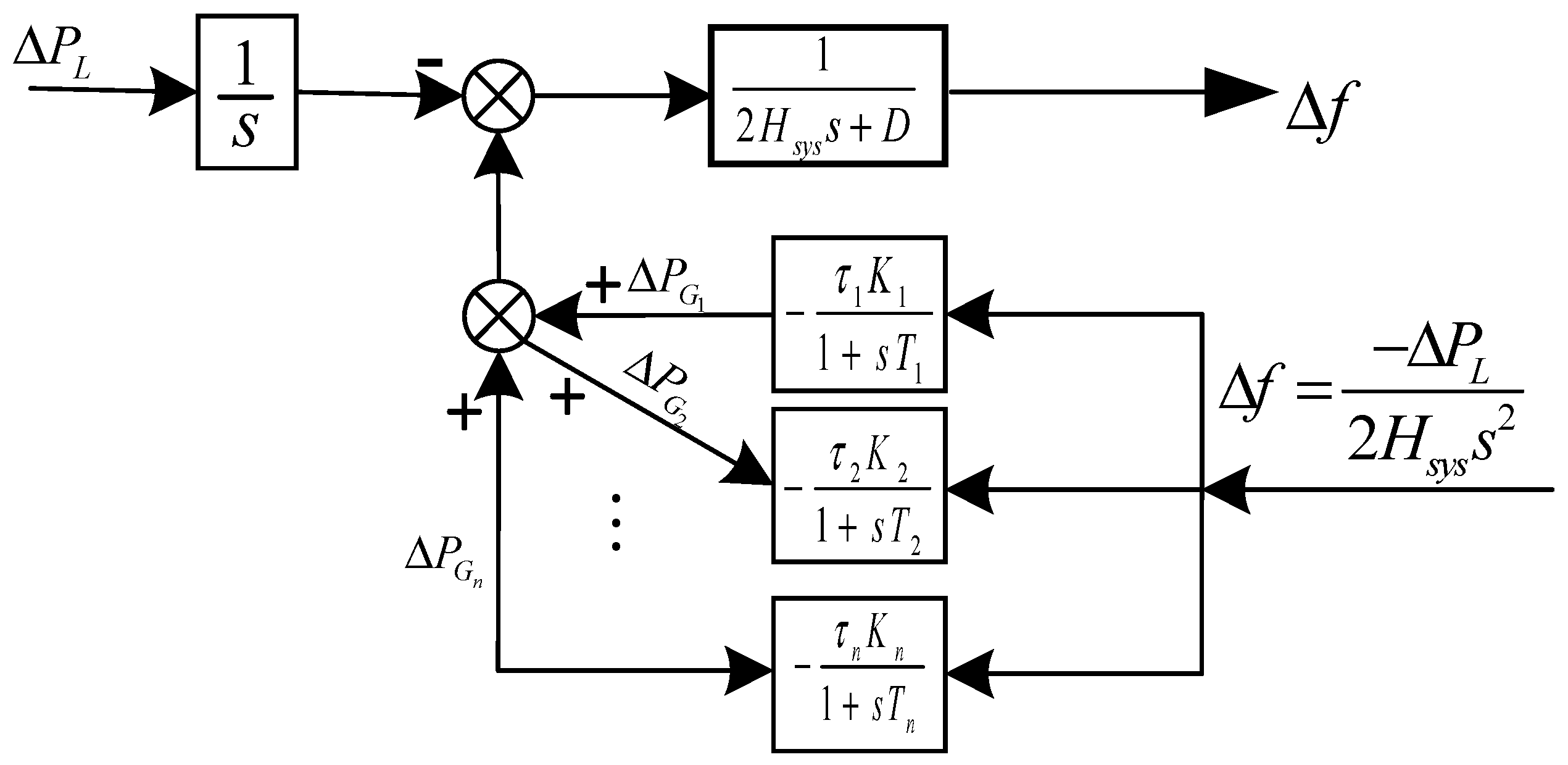
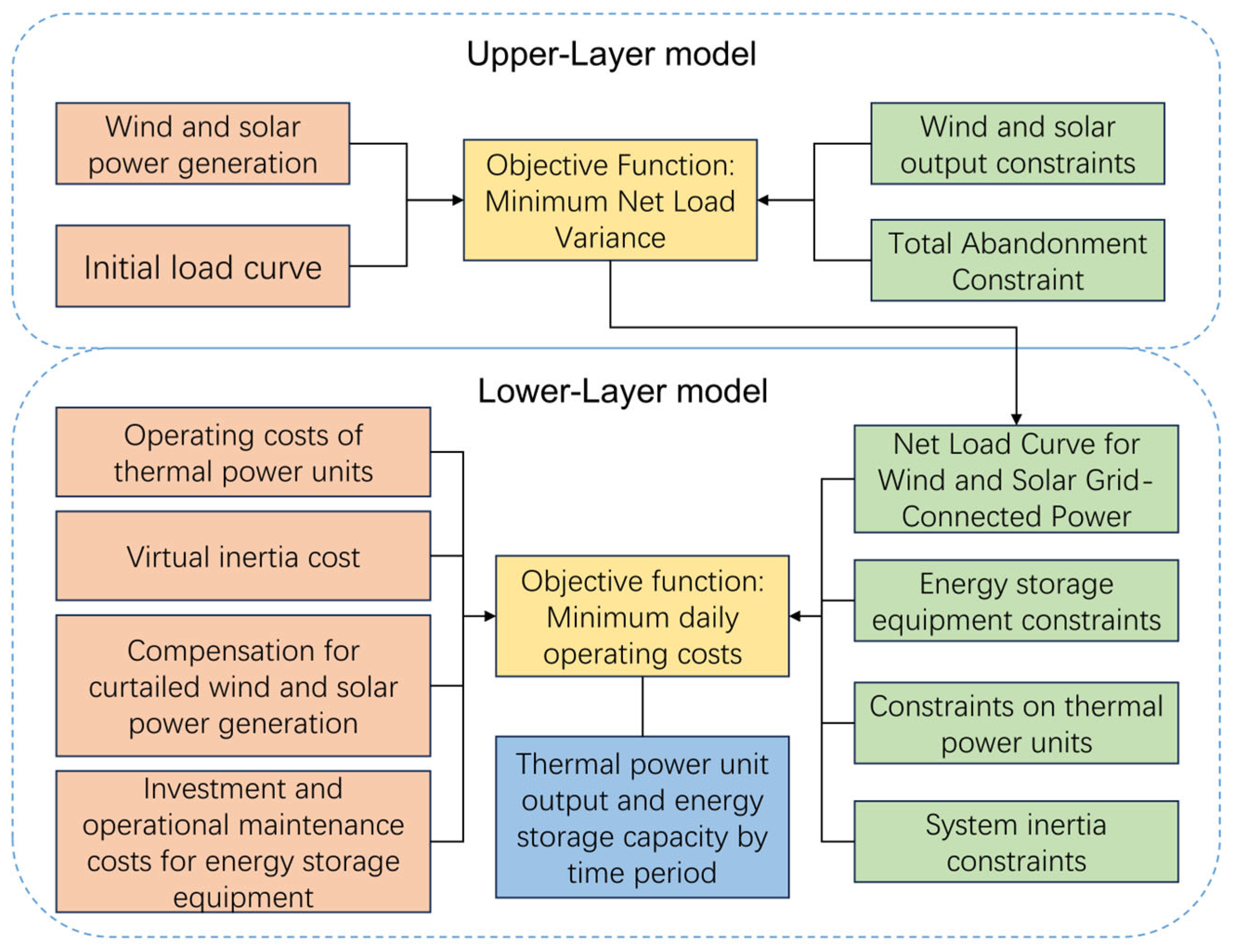

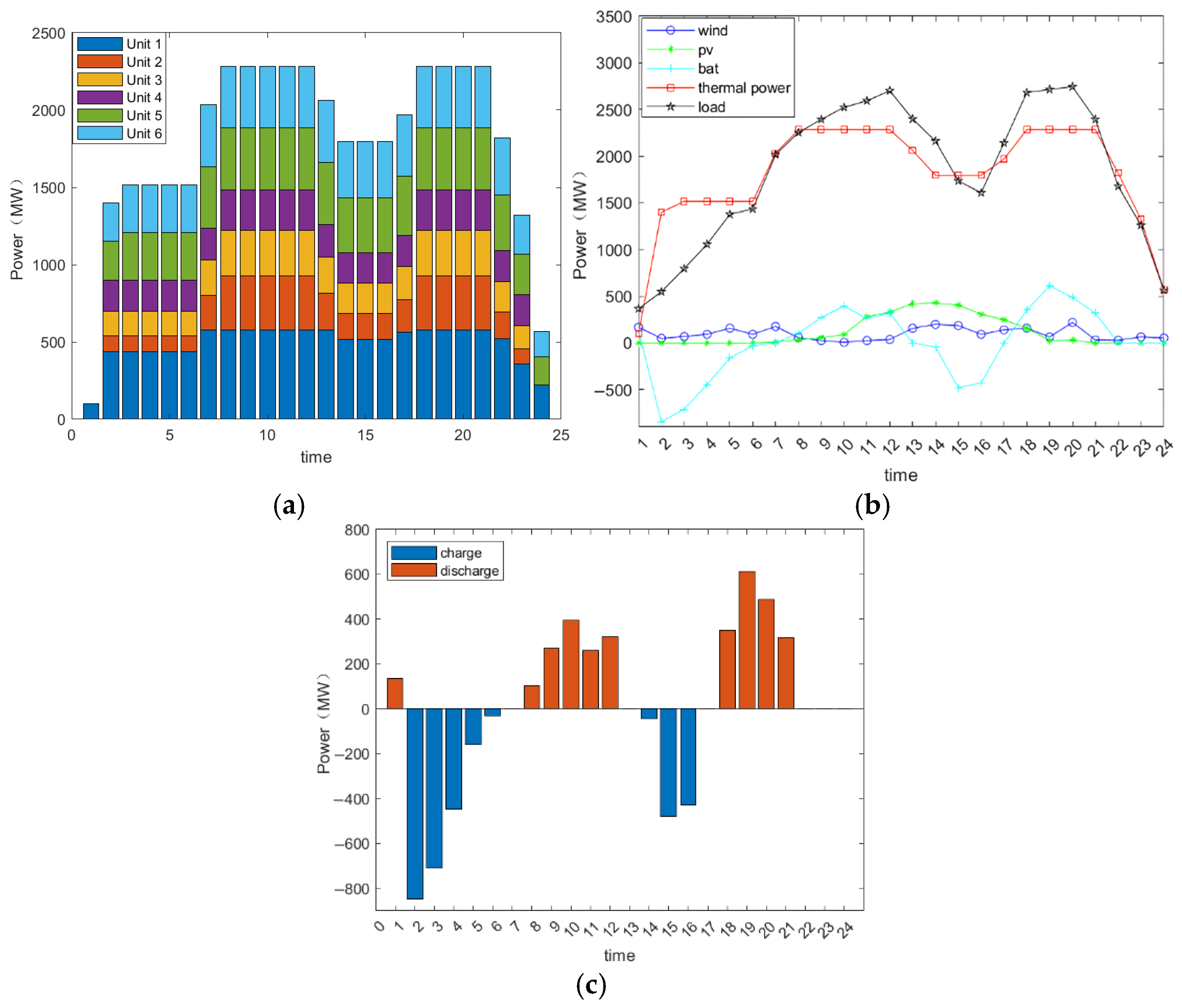
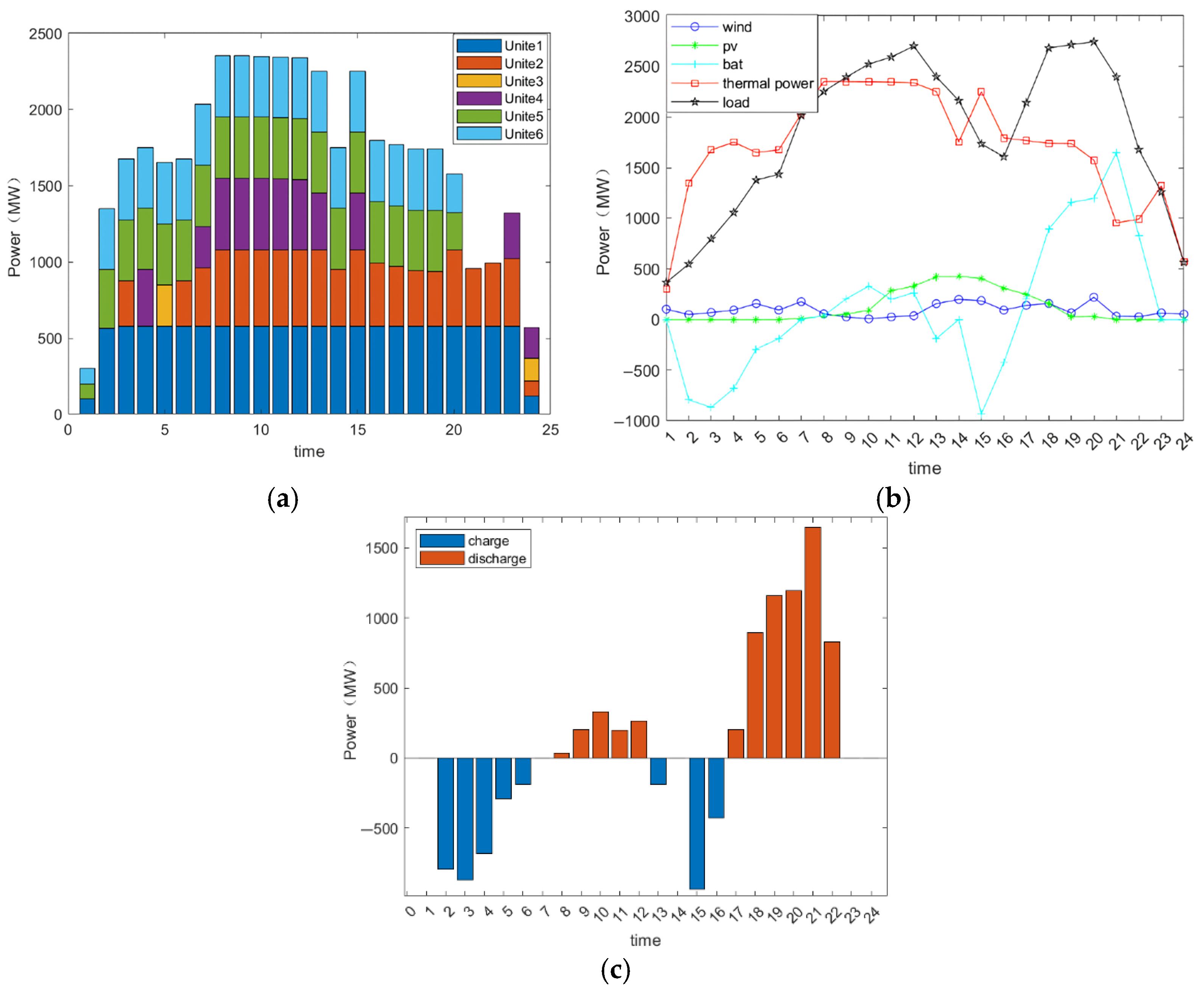
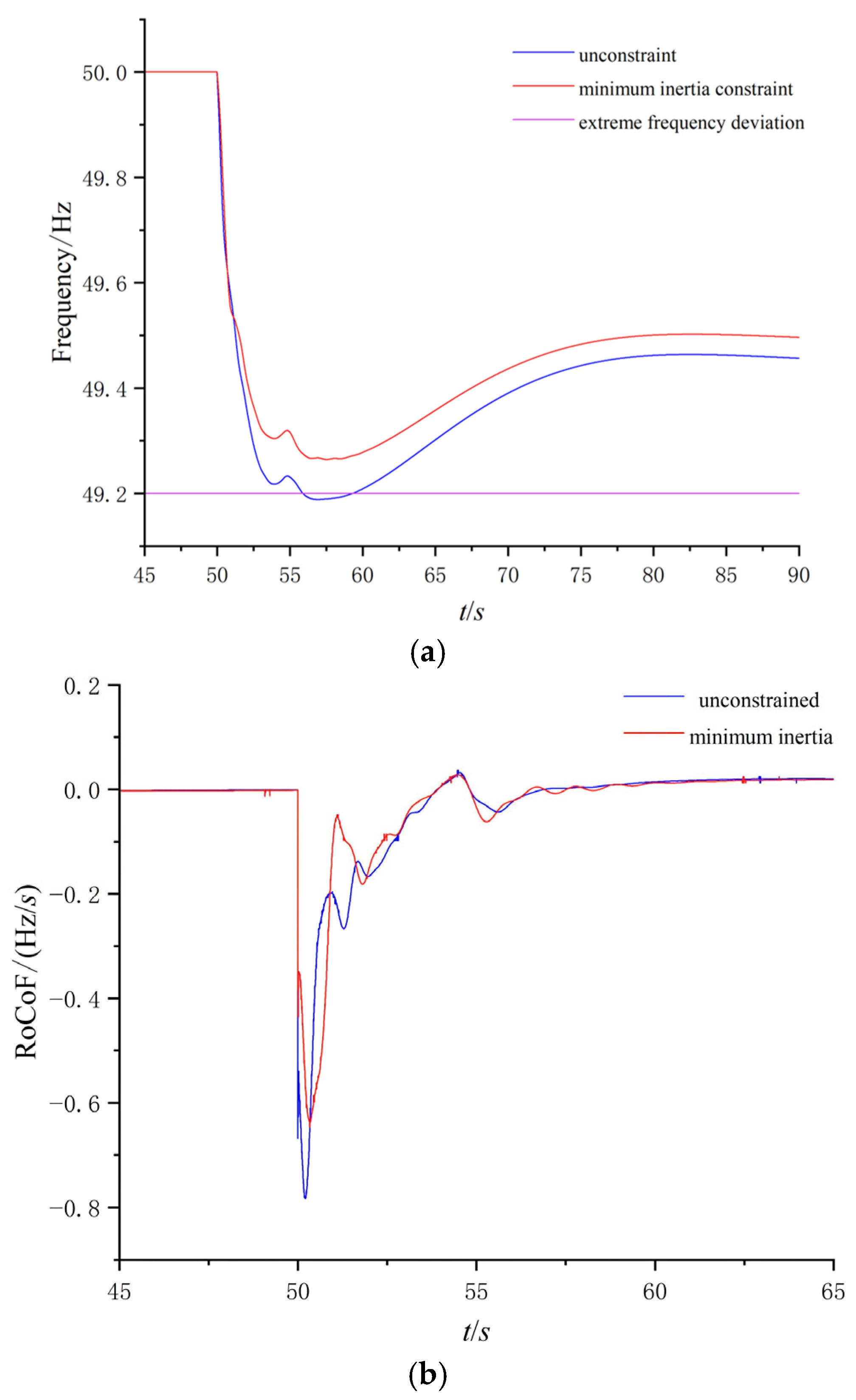
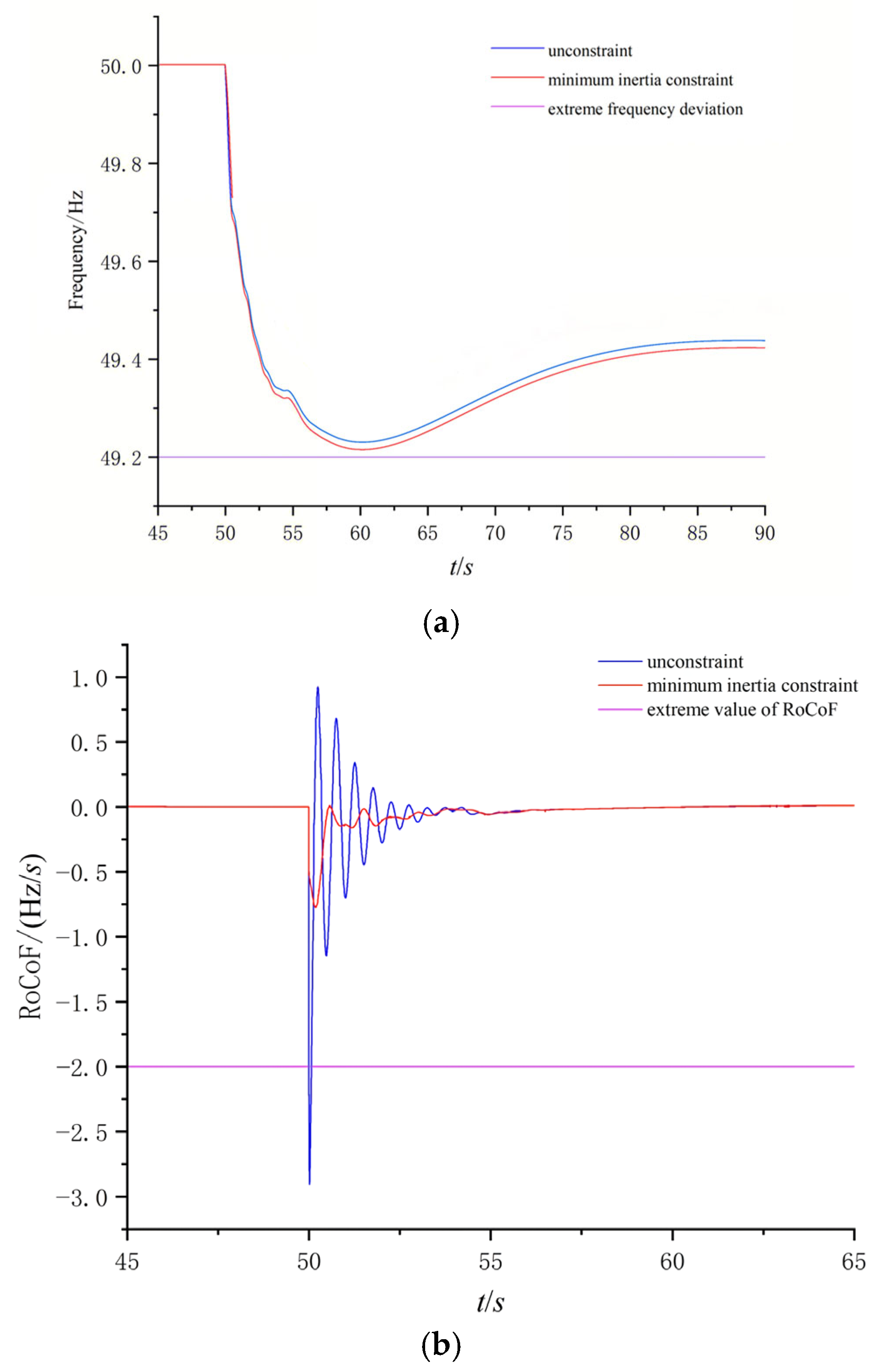



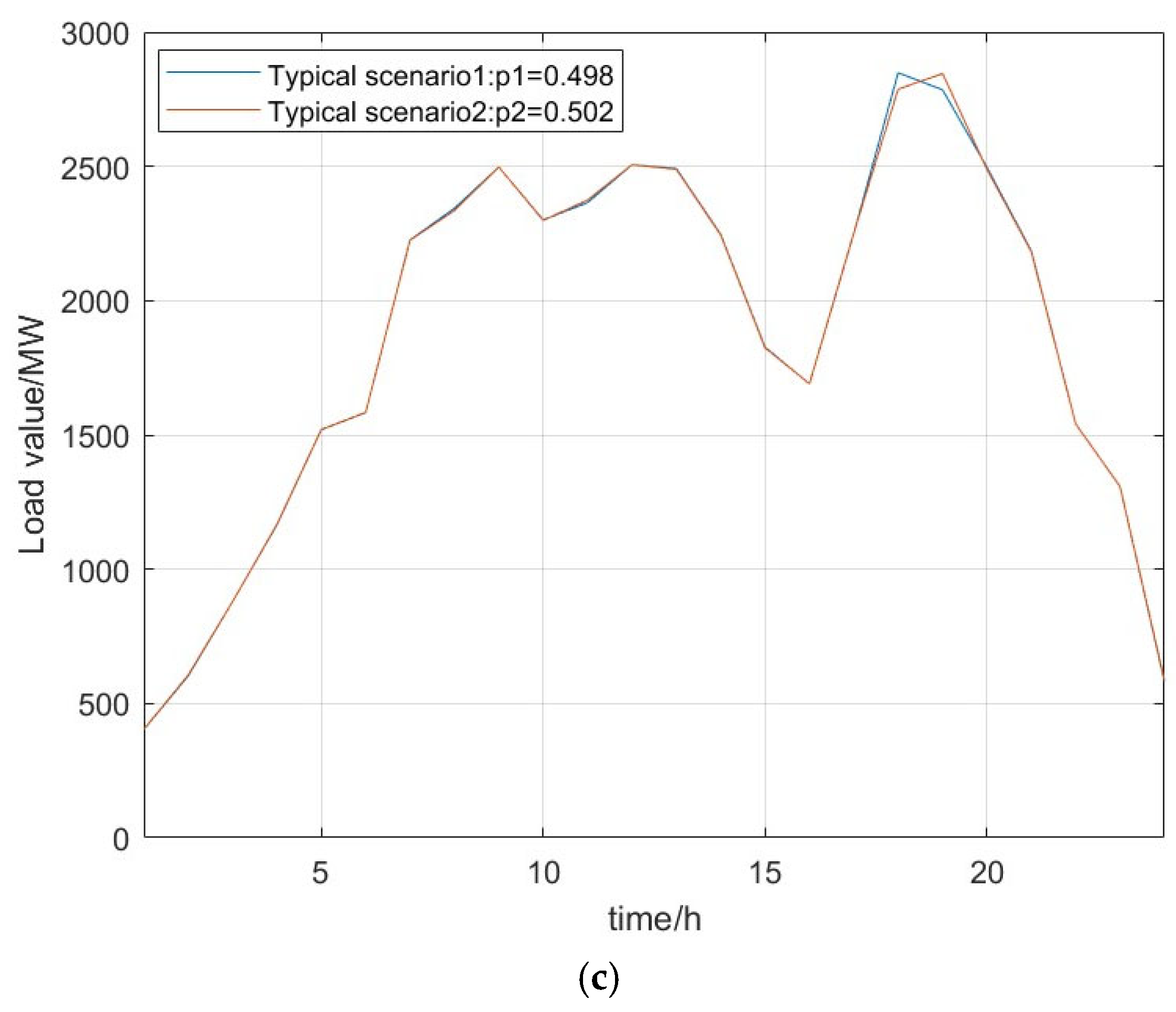
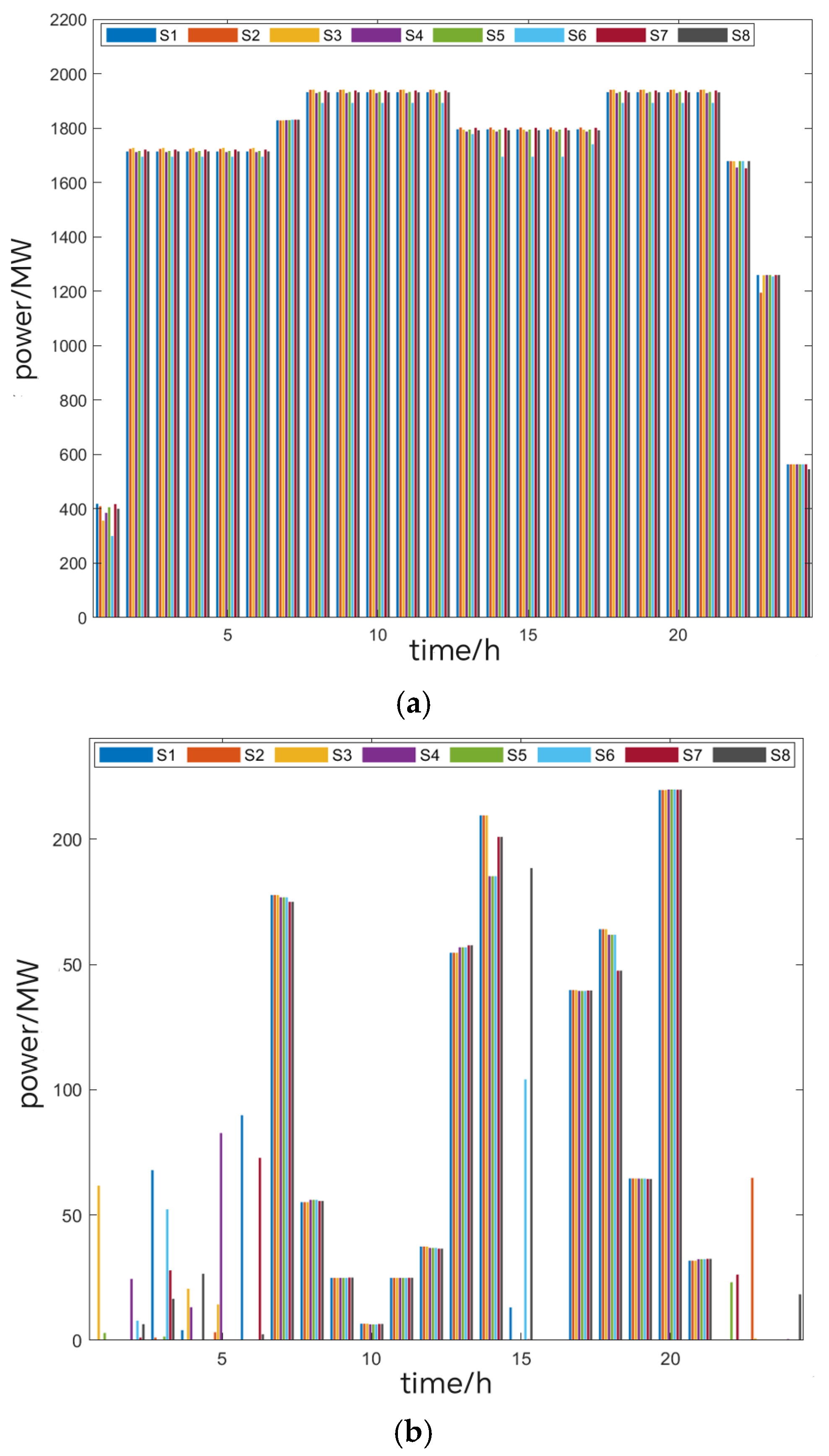
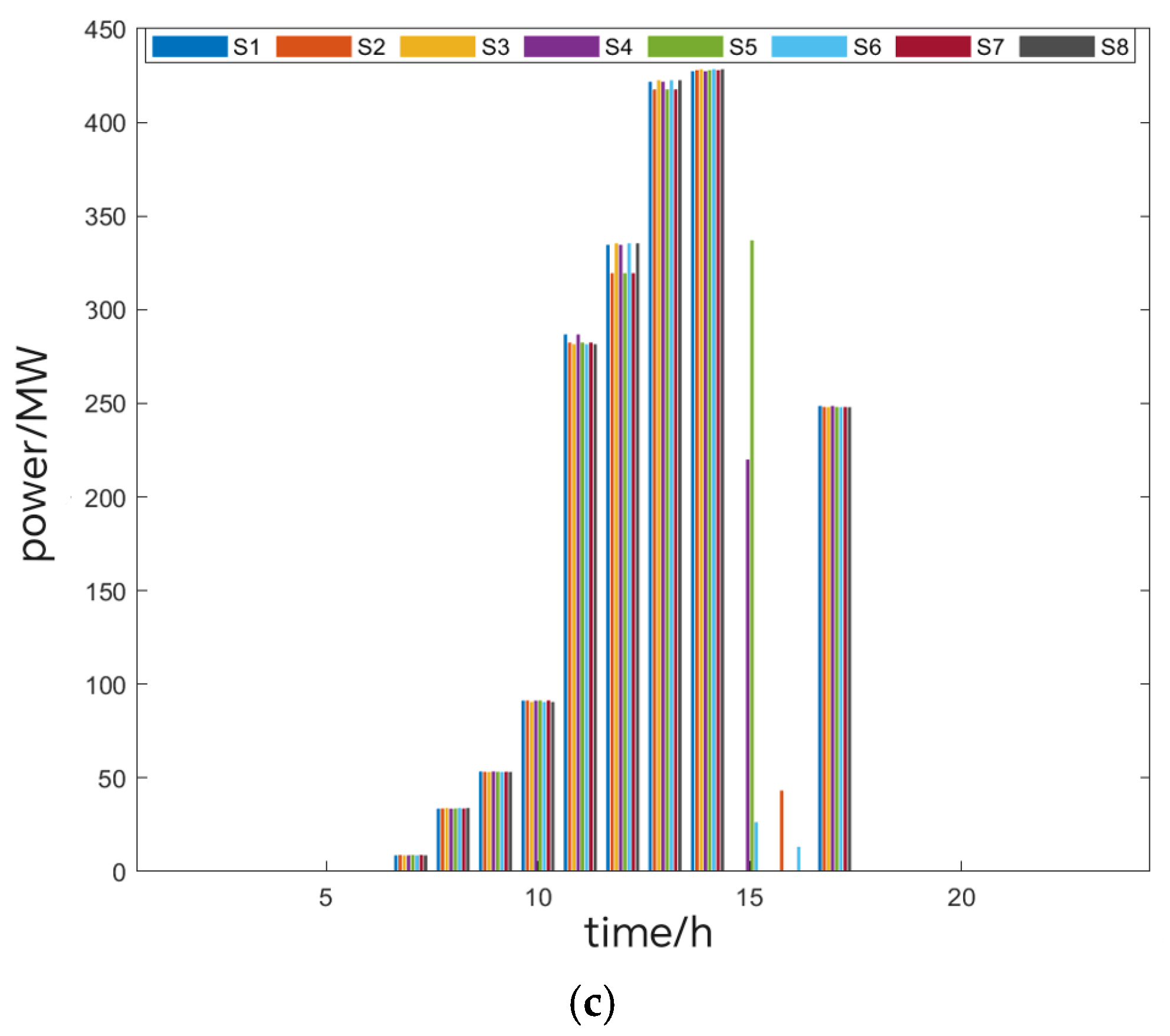
| Unit Number | Pi,max/MW | Pi,min/MW | a | b | c | Ru/Rd | Q | J |
|---|---|---|---|---|---|---|---|---|
| 1 | 575 | 100 | 0.0124 | 38.5397 | 786.7988 | 375 | 39,372.5 | 19,686.25 |
| 2 | 500 | 100 | 0.01508 | 46.1591 | 945.6332 | 300 | 8000 | 6000 |
| 3 | 400 | 150 | 0.028 | 40.3965 | 1049.998 | 150 | 10,000 | 7500 |
| 4 | 600 | 200 | 0.0354 | 38.3055 | 1243.531 | 200 | 20,000 | 10,000 |
| 5 | 400 | 100 | 0.0211 | 36.3278 | 1658.57 | 150 | 10,000 | 5000 |
| 6 | 400 | 100 | 0.0179 | 38.2704 | 1356.659 | 150 | 10,000 | 5000 |
| Unit Number | H | K | R | F |
|---|---|---|---|---|
| 1 | 5.8 | 0.95 | 0.045 | 0.75 |
| 2 | 5.8 | 0.95 | 0.048 | 0.75 |
| 3 | 4.5 | 0.98 | 0.051 | 0.65 |
| 4 | 5.8 | 0.98 | 0.054 | 0.65 |
| 5 | 5.8 | 0.93 | 0.055 | 0.75 |
| 6 | 4.5 | 0.93 | 0.058 | 0.75 |
| Scenario | Costs/yuan | Comparison with Scenario One | Stability |
|---|---|---|---|
| Scenario 1: Without inertia constraints | 194,170.69 | Weaker robustness | |
| Scenario 2: With minimum inertia constraints | 207,979.45 | 7.1% ↑ | Stronger robustness |
Disclaimer/Publisher’s Note: The statements, opinions and data contained in all publications are solely those of the individual author(s) and contributor(s) and not of MDPI and/or the editor(s). MDPI and/or the editor(s) disclaim responsibility for any injury to people or property resulting from any ideas, methods, instructions or products referred to in the content. |
© 2025 by the authors. Licensee MDPI, Basel, Switzerland. This article is an open access article distributed under the terms and conditions of the Creative Commons Attribution (CC BY) license (https://creativecommons.org/licenses/by/4.0/).
Share and Cite
Zhan, H.; Qin, Y.; Xiong, X.; Qi, H.; Hu, J.; Tang, J.; Han, X. A Dual-Layer Optimal Operation of Multi-Energy Complementary System Considering the Minimum Inertia Constraint. Energies 2025, 18, 5202. https://doi.org/10.3390/en18195202
Zhan H, Qin Y, Xiong X, Qi H, Hu J, Tang J, Han X. A Dual-Layer Optimal Operation of Multi-Energy Complementary System Considering the Minimum Inertia Constraint. Energies. 2025; 18(19):5202. https://doi.org/10.3390/en18195202
Chicago/Turabian StyleZhan, Houjian, Yiming Qin, Xiaoping Xiong, Huanxing Qi, Jiaqiu Hu, Jian Tang, and Xiaokun Han. 2025. "A Dual-Layer Optimal Operation of Multi-Energy Complementary System Considering the Minimum Inertia Constraint" Energies 18, no. 19: 5202. https://doi.org/10.3390/en18195202
APA StyleZhan, H., Qin, Y., Xiong, X., Qi, H., Hu, J., Tang, J., & Han, X. (2025). A Dual-Layer Optimal Operation of Multi-Energy Complementary System Considering the Minimum Inertia Constraint. Energies, 18(19), 5202. https://doi.org/10.3390/en18195202




